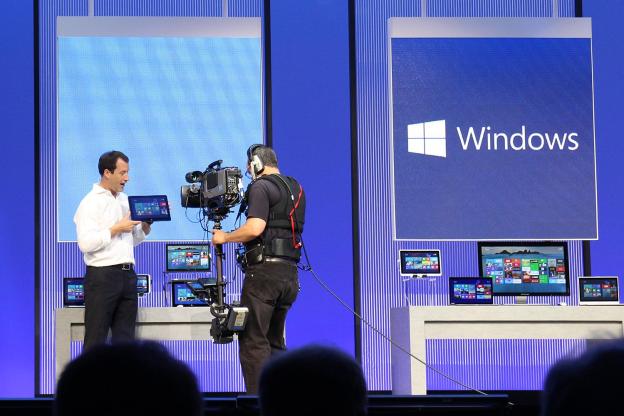
Today Microsoft gave us the first real look at Windows 8.1, its much-anticipated follow up to its controversial new operating system. Steve Ballmer opened with his usual pep-talk, this time highlighting Microsoft’s focus on transforming itself into a company that can make rapid updates “the new norm.”
Windows 8.1 is indeed rapid, as it’s expected to arrive in late 2013, approximately one year after Windows 8. A host of new features and improvements have made their way into the update despite the short development cycle, but are they enough to resolve user complaints? Or is the new development cadence just rapidly delaying the inevitable?
Microsoft is listening
Companies always say that they listen to customers; it’s rare that they actually do. Suddenly, Microsoft seems to be part of the small group that sincerely cares about customer feedback, and Windows 8.1 is evidence of this shift.
The fundamental mismatch between desktop and Metro… might be interpreted as inaction or incompetence.
Virtually all of the improvements and features in Windows 8.1 are an obvious response to consumer complaints both big and small. Search, for example, has been refined so users no longer need to select between searching apps, settings, or the Internet. Microsoft has even taken the idea a step further by seamlessly blending results from different sources into a single interface. This is the kind of innovative user-facing design that Windows seemed content to ignore just a few years ago.
Focusing on feedback is crucial because it highlights a key difference between Microsoft and Apple, a competitor that Redmond has been accused of imitating as of late. While the Build keynote lacked the grace of anything hosted in Cupertino, it also felt more real, more direct. Perhaps this is a calculated ploy to cast aside the company’s reputation as an out-of-touch “evil empire,” or perhaps the motivations are more sincere. In either case, users will benefit.
Desktop or Metro? Take your pick
Listening to feedback is one thing. Implementing the solution is another. And while Microsoft does seem to have its ears open, the chasm between the Windows desktop and the new Metro UI is an issue that’s clearly outside the scope of a one-year development cycle.
With a final, unified solution still out of reach, Redmond’s engineers have decided to leave interface preference up to the user. Those who like Metro, or have a touchscreen device, can use Windows 8.1 with little need to deal with the desktop. Some new customization options will allow users to further personalize the Start Screen and a re-designed app store aims to bring more developers to the platform. Desktop fans, however, can now boot to the desktop directly and access a new Metro-inspired app screen that effectively replaces the function of the Windows 7 start menu.
These features are obviously a concession to user feedback in lieu of a final, all-encompassing solution. While some might accuse Microsoft of backing down in the face of criticism, I think the introduction of improved desktop functionality is a necessary stop-gap measure. The risk that Windows may find itself fractured into two different, yet parallel operating systems is minimal; unlike Google with Android, Microsoft has full control over its operating system and can choose to ax either the desktop or Metro (or both!) in the next full Windows revision.
Delaying the inevitable
While we appreciate the improvements in Windows 8.1, it’s clear that this update is more of a delaying action than any huge step forward. The core problem of competing interfaces in a single operating system remains, and Microsoft said absolutely nothing that indicates how this problem might be resolved. There’s still tomorrow’s keynote to go, but Azure and services will likely be the focus, so we’re not holding our breath for a bombshell announcement.
Microsoft’s silence on the fundamental mismatch between desktop and Metro, and its concession to the desktop audience, might be interpreted as inaction or incompetence. Either accusation is misplaced. Microsoft is merely a victim of its own success. The dominance Windows has left it without the ability to completely transition to the touchscreen because there are hundreds of millions of users who need the desktop and will continue to use the desktop for years. Yet interface design that works for the desktop is terrible for touch, and vice-versa.
There’s a good chance that Microsoft still doesn’t know what to do about this problem, which may be why we’ve received Windows 8.1 and a distinct lack of rumors about what the next full release will feature (most leaks from early this year turned out to be features of Windows 8.1).
The verdict?
Windows 8.1 is a necessary step for Microsoft. Whether it’s a step forward is up for debate, however, as it’s focused on improvements of existing features rather than the serious revamp that’s eventually required. This may be because the development of the next full Windows revision is a tightly kept secret, or it may be because Microsoft doesn’t know what to do. But at least Windows 8.1 will address consumer concerns while we wait to see the company’s next move.
Editors' Recommendations
- How to disable VBS in Windows 11 to improve gaming
- How to schedule an email in Outlook for Mac, Windows, and web
- How to back up Windows 11 and keep all your data safe
- How to recall an email in Outlook on Windows and Mac
- How to split your screen on Windows 11






